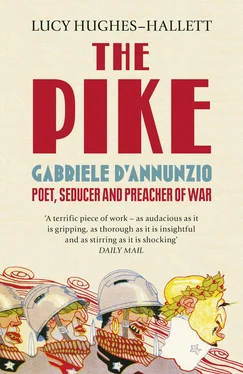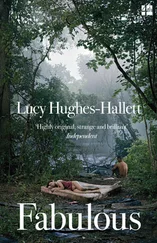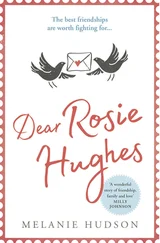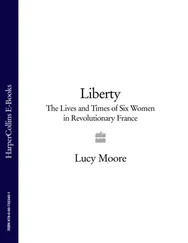On that school outing to Poggio, d’Annunzio had gained access to a grand house by ingratiating himself with the girls. In Rome as an adult he played the same game. In the fencing schools and stables he encountered the young men of the upper classes; he saw them striding, immaculately dressed, up the steps of their clubs; he might share a compartment on a train with them; but he was not one of them. He was a brave horseman, but it would be another twelve years before he became a member of the Circolo della Caccia, the exclusive fox-hunting club. Women, however, were more approachable. Scarfoglio took it for granted that d’Annunzio’s enthusiasm for high society was sexually motivated. ‘As winter opens the doors of the great Roman houses, so he ceded to the flatteries of ladies.’
The three or four streets between the Piazza di Spagna and the Corso – then full of antique shops and jewellers – were his hunting ground where, as he tells it, open-air ‘flirtation’ (his English) was rife. In a teasing piece for La Tribuna he described the erotic opportunities shopping afforded. ‘Your hand can brush furtively against a lady’s, in feeling an embroidered silk.’ Advice on the choice of a Christmas present, he explained to his readers, can have ‘an infinity of madrigals’ as its subtext. ‘You can tell her you have seen an unusual object in a little-known curio shop and offer to accompany her there, and as the two of you bend over to inspect the knick-knack in question you will feel your ear tickled by her hair.’ And then, a little later, you can play on the memory of that intimacy. ‘“Do you remember Duchess … You were wearing a chestnut-coloured mantle trimmed with chinchilla, and you were so fair, at Janetti’s shop, standing in a ray of sunlight, between a piece of marquetry and a screen of leather tooled with silver and rose-coloured chimeras … You were so beautiful that morning … And you were so kind … and sweet … etc. etc. Do you remember?” If the Duchess remembers, you’ve almost certainly made a conquest.’
It is not hard to guess of whom he was thinking. In April 1883, a couple of months after he wrote his last letter to Elda, d’Annunzio attended a gathering of high-ranking ladies in the Palazzo dei Conservatori. The piece he wrote is his usual confection of artistic references, fashion notes and social gazette. He mentions the Duchessa di Gallese, serene in crushed velvet, and notes that she smiles frequently at her blonde daughter, Maria, who stands by a marble statue and wears a white plume. D’Annunzio ends the piece with an enigmatic reference to a pair of ‘living turquoises speckled with gold’ beneath long eyelashes. In his scandalous poem, Peccato di Maggio (Sin in May) published the following month, he describes seducing a young woman with just such eyes. Shortly thereafter he and Maria di Gallese eloped.
He wrote to Nencioni: ‘Finally, I have given myself up entirely to love, forgetting myself and everything else.’ The Duchessina Maria Hardouin di Gallese (pictured overleaf with their son Mario) was a year younger than him, described by a contemporary as ‘a graceful creature, fragile, an eighteenth-century pastel … the image of poetry’.
The family bore a noble name, but neither of Maria’s parents was born into the ancient aristocracy. Her father was the son of a clockmaker from Normandy, who had come to Rome as a junior officer in the French army in 1849. Billeted in the Gallese palace, or perhaps just frequenting the stable yard, he had met, wooed and won the widowed duchess, marrying her and – thanks to a special papal decree – sharing her title. When she died he married again, to a much younger woman of the bourgeoisie. But however come by, the duke’s title was ancient and respected; his home, the fifteenth-century Palazzo Altemps, was imposing; his second wife, Maria’s mother, was a court insider and lady-in-waiting to the Queen.
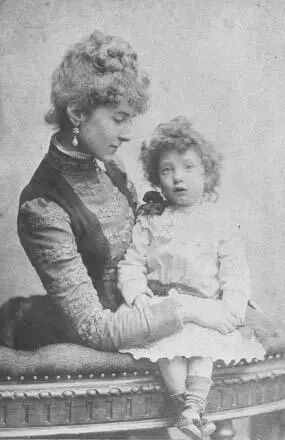
Persistent gossip suggests that it was the duchess who first became interested in d’Annunzio. She was described by her neighbour, Count Luigi Primoli, who would become a good friend of d’Annunzio’s, as ‘graceful, seductive, but as hysterical as the heroine of a novel’. Primoli adds that she was constantly going about with poets. In her salon writers and artists met high society. This was the kind of inclusive circle into which d’Annunzio could have been invited. Or perhaps he met mother and daughter with Primoli, who also made a practice of inviting ‘the two aristocracies, of the mind and the blood’, to meet. D’Annunzio certainly visited his house at about this time, and wrote fondly of a ‘mysterious corner’ where a little low divan in a heavily curtained alcove, half screened by a palm tree, provided the perfect place to ‘converse in peace with a lady’.
Whatever may have passed between d’Annunzio and the duchess, he soon transferred his interest to her daughter. Count Primoli, recounting the affair in his diary, imagines Maria finding him in a corner of the palace. ‘A young poet … as beautiful as a mediaeval page. Was he there for her mother? She took him for herself.’ It wasn’t difficult for the young couple to meet. Later, Maria wrote nostalgically to Primoli of how she would ooh! and aah! at the lovely things in Janetti’s shop window, or buy violets from the flower stall in the Piazza di Spagna (in Pleasure all the ladies carry little posies of violets inside their muffs). D’Annunzio was frequently there too. Soon they were meeting while out riding as well. And if Sin in May is to be taken as the description of an actual event, those outdoor assignations were soon deliriously pleasurable. In a wood where blackbirds sing, the poem’s narrator falls to his knees before his ‘slim blonde companion’. His hands play upon her body like a harp. She hangs over him, swaying, swooning. They lie down. Her tumbled hair forms a bed on which she stretches out: ‘I felt/The points of her breasts rising, at the lascivious/Approach of my fingers, like fleshy flowers …’. A rigor as of death freezes her, but ‘she revives as on a wave of pleasure./I bend entire over her mouth, as if to drink from a chalice, trembling at the conquest.’
The woman in the poem is called Yella (a diminutive of Mariella, a common variant of Maria). D’Annunzio was being flagrantly indiscreet, perhaps having calculated that the only way he could win Maria was by compromising her beyond redemption. The duke might himself be an upstart who had entered the ranks of the nobility by way of the bedroom: it did not follow that he would welcome a son-in-law who followed his lead. Quite the reverse. Some time early that summer Maria became pregnant (Mario d’Annunzio was born the following January), but still her father adamantly refused to sanction her marriage to the ‘penny-a-liner’.
On 28 June 1883, Gabriele d’Annunzio and Maria di Gallese took the train to Florence. Their flight was widely reported: d’Annunzio himself had probably tipped off the press. There was some attempt to veil the impropriety: most journalists covering the scandalous elopement alleged that the pair were met at the railway station (telegrams flying faster than trains) by the prefect of police, and sent straight back to Rome. It was a polite fiction. It was not until the following morning that the prefect found them at the Hotel Helvetia. Maria was hustled back to Rome, but by passing the night together in a public place the lovers had ensured that Maria’s parents would be obliged to permit their marriage.
To permit, but not to approve or bless. The duke was so outraged at a mere writer having carried off his girl that he wouldn’t attend their wedding in the chapel in the Palazzo Altemps. Worse, he refused to give Maria and her new husband any financial support, or ever to meet them. To do him justice, d’Annunzio has left no sign that he was disappointed by Maria’s lack of dowry, or by the fact that as an outcast she was unable to provide him with an entrée to the aristocratic circles that fascinated him so. The couple left town to enjoy a marital idyll. Maria was d’Annunzio’s pearl-pale, high-born damozel and he was her curly-headed page, and for a while they were entirely happy. He took her off to Pescara and lived there with her for over a year in his father’s Villa Fuoco, revelling in his freedom to enjoy a legitimate ‘horizontal life’ with his delicately lovely wife. When eventually he returned to Rome he took on another dependant. Maria’s parents separated soon after their daughter’s hasty marriage and, for a while, the duchess lived with d’Annunzio and Maria. If d’Annunzio was a fortune-hunter, he was an inept one. Instead of riches and position, he had acquired for himself two disgraced and dependent women whose upkeep he could ill afford.
Читать дальше
